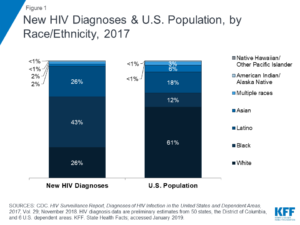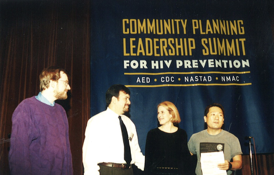Most of  us never read congressional committee reports; however, a subcommittee of the House Appropriations Committee (then click on FY2020 Bill Report) wrote language that could change the course of the HIV epidemic in America. We still have an uphill battle in the Senate. NMAC is very concerned about the Budget Control Act caps. Below is the actual language (in boxes) from the House report, starting on page eight of the 346-page report.
us never read congressional committee reports; however, a subcommittee of the House Appropriations Committee (then click on FY2020 Bill Report) wrote language that could change the course of the HIV epidemic in America. We still have an uphill battle in the Senate. NMAC is very concerned about the Budget Control Act caps. Below is the actual language (in boxes) from the House report, starting on page eight of the 346-page report.
HIV INITIATIVE
The Committee invests in a new HIV initiative to reduce transmission of HIV by 90 percent in the next 10 years. The bill includes an increase of nearly $500,000,000 for HIV research, prevention, and treatment—almost twice the size of the increase requested by the Administration.
The bill includes an increase of $170,000,000 for HRSA programs—including Ryan White and Community Health Centers—to increase the use of pre-exposure prophylaxis (PrEP) among people at high risk for HIV transmission and to increase the use of antiretroviral therapy (ART) for individuals living with HIV.
The bill also includes $140,000,000 for CDC activities to diagnose people with HIV as early as possible after infection, link people to effective treatment and prevention strategies, and respond rapidly to clusters and outbreaks of new HIV infections. There is also an increase of $16,919,000 for School Health-HIV and an increase of $17,000,000 for the Minority AIDS Initiative, a cross-cutting initiative to improve prevention, care, and treatment for minority populations disproportionately affected by HIV.
Furthermore, the Committee rejects the Administration’s proposal to cut NIH’s HIV research budget by more than $400,000,000. Instead, the Committee continues to invest in research that led to breakthroughs in current treatments such as PrEP and ART. The bill includes an increase of $149,000,000 for NIH to continue funding research that could lead to an HIV vaccine or a cure.
 NMAC and the Partnership to End the Epidemics submitted policy language for the subcommittee to consider. Read the full report (click on FY 2020 Bill Report), there are many additional recommendations on HIV as well as STIs and Hepatitis. The language is important because federal agencies are required to follow these directives. However, the Senate could add additional directives and the differences will need to be worked out in conference. Here are some of the items that caught NMAC’s attention:
NMAC and the Partnership to End the Epidemics submitted policy language for the subcommittee to consider. Read the full report (click on FY 2020 Bill Report), there are many additional recommendations on HIV as well as STIs and Hepatitis. The language is important because federal agencies are required to follow these directives. However, the Senate could add additional directives and the differences will need to be worked out in conference. Here are some of the items that caught NMAC’s attention:
Community-Based Organizations. —The Committee recognizes that community-based organizations play a crucial role because of their capacity to reach communities highly impacted by HIV. The Committee directs CDC to ensure that planning councils reflect their local epidemic by including community-based organizations and people living with HIV. The Committee further requests CDC’s progress of engaging such communities be included in the fiscal year 2021 Congressional Budget Justification.
2020 AIDS Conference. —The Committee recognizes the United States is hosting the International AIDS Conference for the first time since 2012. The Committee includes $5,100,000 for the U.S. contribution to the AIDS2020 Conference.
Office of AIDS Research. —The Committee directs NIH to increase funding for HIV/AIDS research by at least the same percentage as the increase in NIH overall funding. The Committee recognizes that OAR’s AIDS allocation to each IC is based on scientific need and opportunity. Therefore, individual IC AIDS budgets may not each grow at the same rate, but total AIDS and non-AIDS funding will continue to grow at a comparable rate.
Sexual Risk Avoidance. —The Committee includes no funding for grants to implement education in sexual risk avoidance, also known as abstinence-only until marriage programs.
 The directive about CBOs considered policy language from NMAC and the Partnership to End the Epidemics. Planning councils must reflect the demographics of their local HIV epidemic. The House added the enforcement language. While we still have to wait for the Senate, NMAC hopes the planning directives to the 58 jurisdictions going out in June will reflect the House’s language. The Partnership also pushed for language about CBOs getting funded because in some jurisdictions not enough money flows to community. NMAC agrees with the House that CBOs are best able to reach the communities that are highly impacted by HIV.
The directive about CBOs considered policy language from NMAC and the Partnership to End the Epidemics. Planning councils must reflect the demographics of their local HIV epidemic. The House added the enforcement language. While we still have to wait for the Senate, NMAC hopes the planning directives to the 58 jurisdictions going out in June will reflect the House’s language. The Partnership also pushed for language about CBOs getting funded because in some jurisdictions not enough money flows to community. NMAC agrees with the House that CBOs are best able to reach the communities that are highly impacted by HIV.
NMAC was very pleased by the directive to ensure that NIH increases HIV/AIDS research funding by the same percentage as the increase to NIH’s overall budget. This has been a longstanding agreement. We encourage the Senate to include a similar directive.
 Science has proven that abstinence only sexual health education does not work. We commend the House for following the science and defunding sexual risk avoidance. These programs run contrary to our HIV prevention work and our goal to get 1.1 million Americans on PrEP. Comprehensive sexual health education, including education about PrEP, is the only way to end the HIV epidemic.
Science has proven that abstinence only sexual health education does not work. We commend the House for following the science and defunding sexual risk avoidance. These programs run contrary to our HIV prevention work and our goal to get 1.1 million Americans on PrEP. Comprehensive sexual health education, including education about PrEP, is the only way to end the HIV epidemic.
 While we face an uphill battle in the Senate, the House provided a template for the HHS budget that starts our work to end the HIV epidemic in America. Using 2019 funds from the Minority AIDS Initiative, HHS will put out a notice of the availability of funding in June to the 58 jurisdictions to support the start of their planning process. Things are moving and shifting quickly, we look forward to seeing you at this year’s United States Conference on AIDS. This year’s meeting will focus on the federal plan to end the HIV epidemic. NMAC is pleased to announce that the National Institutes of Allergies and Infectious Diseases will bring representatives from all of the Centers for AIDS Research (CFARs) to USCA. It is very important that we work collaboratively to end the epidemic.
While we face an uphill battle in the Senate, the House provided a template for the HHS budget that starts our work to end the HIV epidemic in America. Using 2019 funds from the Minority AIDS Initiative, HHS will put out a notice of the availability of funding in June to the 58 jurisdictions to support the start of their planning process. Things are moving and shifting quickly, we look forward to seeing you at this year’s United States Conference on AIDS. This year’s meeting will focus on the federal plan to end the HIV epidemic. NMAC is pleased to announce that the National Institutes of Allergies and Infectious Diseases will bring representatives from all of the Centers for AIDS Research (CFARs) to USCA. It is very important that we work collaboratively to end the epidemic.
Yours in the struggle,
Paul Kawata
30 Years of Service
![]()
![]()
